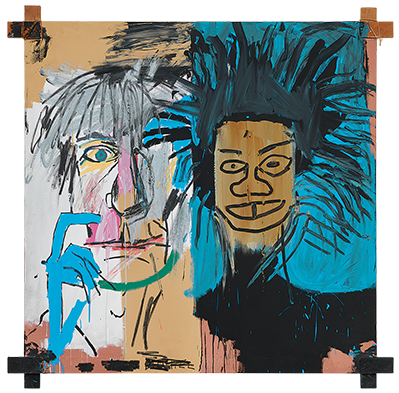바스키아X워홀(BASQUIAT X WARHOL) @브랜트재단(11/1-1/7, 2024)
BASQUIAT x WARHOL
November 1st to January 7th, 2024
The Brant Foundation New York

The Brant Foundation is pleased to announce Basquiat x Warhol at the Foundation’s East Village location, curated by Dr. Dieter Buchhart in collaboration with Dr. Anna Karina Hofbauer. On view November 1, 2023 through January 7, 2024, this is the first time the collaboration has been the subject of a major New York exhibition since Andy Warhol & Jean-Michel Basquiat at Gagosian Gallery in 1997. The exhibition is traveling from Fondation Louis Vuitton in Paris, France, and has benefited from the collaboration between the two institutions.
The Brant Foundation opened its East Village space in 2019 with a landmark exhibition of Jean-Michel Basquiat, reuniting the East Village with a legendary artist who had a profound influence on the downtown arts community. This past spring, the Foundation presented Thirty Are Better Than One, a career-encompassing Andy Warhol exhibition, bringing to the space yet another leading artist of postwar New York. Now, with Basquiat x Warhol, the Foundation presents the artists together with a selection of masterpieces from their influential collaboration in the early eighties, unseen together in New York for over 20 years.
Basquiat and Warhol occupied two distinct spaces in New York’s 1980s art scene. Although the two artists were familiar with each other—Warhol had even purchased two of Basquiat and Jennifer Stein’s early Anti-Product Baseball Cards in 1979 —it was not until their formal introduction at Warhol’s Factory in 1982 did the two form a friendship that would result in one of the most iconic collaborations of the 20th century.
On October 4, 1982, gallerist Bruno Bischofberger invited Jean-Michel Basquiat to Andy Warhol’s Factory to formally introduce the two artists. Warhol took a Polaroid of Basquiat and after a few shots, Basquiat asked Bischofberger to photograph him and Warhol together. Enthused by the encounter, Basquiat left immediately, and, according to Warhol, “within two hours” his assistant, Stephen Torton, appeared with a double portrait of the two artists, Dos Cabezas (1982).
In 1984, Basquiat and Warhol pursued a separate yet cooperative practice that would result in over 160 canvases. Meeting almost every day, the pair would work on multiple monumental canvases at once, from early hours into the evening. This enthusiastic exchange of energy is exemplified in their paintings, which illustrate a back and forth between that is both tense and complimentary. As stated by Basquiat, “Andy would start one [painting] and put something very recognizable on it, or a product logo, and I would sort of deface it. Then I would try to get him to work some more on it, I would try to get him to do at least two things.” The paintings are rife with both artists’ unique iconographies: Warhol’s screen-printed advertisements and cultural symbols are effaced by Basquiat’s iconic figures and signs; newspaper headlines included by Warhol are obscured and rewritten by Basquiat; scenes painted in Basquiat’s conceptual Neo-Expressionist style are joined by Warhol’s precise appropriations of brand logos. The artists also influenced each other: Warhol at times returned to his painterly beginnings, and Basquiat increased his use of the silkscreen-printing technique. “I drew it first and then I painted it like Jean-Michel,” said Warhol. “I think those paintings we’re doing together are better when you can’t tell who did which parts.”
The artist’s collaboration expanded beyond paintings as well. Ten Punching Bags (Last Supper) (1985-86) is a monumental sculpture of ten punching bags depicting portraits of Jesus Christ and repetitions of the word “JUDGE” referencing Catholic guilt—a recurring theme in Warhol’s later works—and the impact of the AIDS epidemic. Traversing artistic generations, Basquiat and Warhol’s collaboration tackled sociopolitical issues such as police brutality, colonialism, gentrification, and commodification. Keith Haring described their practice as “a physical conversation happening in paint instead of words.” In many ways their collaboration was an opportunity to jointly examine the socio-political upheaval and loss of friends and acquaintances in the 1980s.
“In their collaboration, Jean-Michel Basquiat and Andy Warhol came together and opened new ideas and spaces of thought that mirror both our present time as well as the past and future. The results are brilliant artworks that continue to have an impact in our own time as they appear to address pressing and highly relevant contemporary topics such as racism and consumerism. Their collaboration was a unique project and probably one of the greatest and most enduring in all of art history,” says Dr. Buchhart.
Sixteen of the paintings were first shown to the public in 1985 at Tony Shafrazi’s New York gallery. Nevertheless, the exhibition received a cold reception by the media, which eventually lead to the end of their collaboration later that year. Both artists continue to have monumental individual success after their deaths in the late eighties, although few exhibitions have focused on their collaborative artworks. Basquiat x Warhol at the Brant Foundation reasserts the impact of artistic collaboration across generations and genres while showcasing their shared inspirations, mutual trust, and political concerns.
The Brant Foundation extends its gratitude towards its Lead Exhibition Partner, American Express Platinum. Art is a passion point for American Express Platinum Card® Members, and through the company’s By Invitation Only® program they will have access to an exclusive two-day ticket pre-sale starting September 22, 2023, Platinum-only time slots for the entire run and special VIP access, including the exhibition opening, a private tour, and curator-led panel.
The Brant Foundation Art Study Center
421 East 6th Street, New York, NY 10009
https://www.brantfoundation.org





